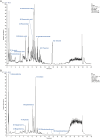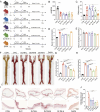Danlian-Tongmai formula improves diabetic vascular calcification by regulating CCN3/NOTCH signal axis to inhibit inflammatory reaction
- PMID: 39834821
- PMCID: PMC11743396
- DOI: 10.3389/fphar.2024.1510030
Danlian-Tongmai formula improves diabetic vascular calcification by regulating CCN3/NOTCH signal axis to inhibit inflammatory reaction
Abstract
Background: Vascular calcification (VC) commonly occurs in diabetes and is associated with cardiovascular disease incidence and mortality. Currently, there is no drug treatment for VC. The Danlian-Tongmai formula (DLTM) is a traditional Chinese medicine (TCM) prescription used for diabetic VC (DVC), but its mechanisms of action remain unclear. This study aims to elucidate the effects of DLTM on DVC and explore the underlying mechanisms of action.
Methods: Ultra-high-performance liquid chromatography-mass spectrometry (UHPLC-MS) was used to identify the metabolites of DLTM. A DVC rat model was established using streptozotocin (STZ) combined with vitamin D3 (VitD3). The effects of DLTM on DVC were evaluated through alizarin red staining, calcium deposition, and changes in osteogenic and contractile markers. The specific molecular mechanism of DLTM in treating diabetic VC was comprehensively analyzed by transcriptomics, molecular docking and in vivo experimental verification.
Results: We identified 108 major metabolites of DLTM. In vivo, high-dose DLTM significantly alleviated VC in diabetic rats. Transcriptomic analysis showed that DLTM treatment markedly altered the transcriptomic profile of rat aortas, which was associated with regulating the CCN3/NOTCH signaling pathway, promoting vascular smooth muscle contraction, and inhibiting the inflammatory responses. Molecular docking and molecular dynamics simulation demonstrated strong binding interactions between DLTM metabolites and key molecules within the CCN3/NOTCH pathway, including NOTCH1, DLL1, DLL4, hes1, and hey1. In vivo experiments confirmed that DLTM could upregulate CCN3, inhibit the activation of NOTCH signaling ligands DLL1 and downstream transcription factors hes1 and hey1, and reduce the release of inflammatory cytokines IL6, IL1β, and TNFα.
Conclusion: DLTM alleviates DVC by regulating the CCN3/NOTCH signaling axis to inhibit inflammatory responses. Our research provides experimental basis for clinical treatment and drug transformation of diabetic VC.
Keywords: CCN3; Danlian-Tongmai formula; UHPLC-MS; notch signaling; vascular calcification.
Copyright © 2025 Wang, Li, Zhu, Xu, Cui, Liu and Liu.
Conflict of interest statement
The authors declare that the research was conducted in the absence of any commercial or financial relationships that could be construed as a potential conflict of interest. The author(s) declared that they were an editorial board member of Frontiers, at the time of submission. This had no impact on the peer review process and the final decision.
Figures







Similar articles
-
CCN3 and DLL1 co-regulate osteogenic differentiation of mouse embryonic fibroblasts in a Hey1-dependent manner.Cell Death Dis. 2018 Dec 11;9(12):1188. doi: 10.1038/s41419-018-1234-1. Cell Death Dis. 2018. PMID: 30538222 Free PMC article.
-
Indoxyl Sulfate-induced Vascular Calcification is mediated through Altered Notch Signaling Pathway in Vascular Smooth Muscle Cells.Int J Med Sci. 2020 Sep 23;17(17):2703-2717. doi: 10.7150/ijms.43184. eCollection 2020. Int J Med Sci. 2020. PMID: 33162798 Free PMC article.
-
Alleviating vascular calcification with Bushen Huoxue formula in rats with chronic kidney disease by inhibiting the PTEN/PI3K/AKT signaling pathway through exosomal microRNA-32.J Pharm Pharmacol. 2025 Apr 3;77(4):550-563. doi: 10.1093/jpp/rgae120. J Pharm Pharmacol. 2025. PMID: 39440885
-
Potential Actions of Baicalein for Preventing Vascular Calcification of Smooth Muscle Cells In Vitro and In Vivo.Int J Mol Sci. 2022 May 18;23(10):5673. doi: 10.3390/ijms23105673. Int J Mol Sci. 2022. PMID: 35628483 Free PMC article.
-
The Bone-Vascular Axis: A Key Player in Chronic Kidney Disease Associated Vascular Calcification.Kidney Dis (Basel). 2024 Sep 6;10(6):545-557. doi: 10.1159/000541280. eCollection 2024 Dec. Kidney Dis (Basel). 2024. PMID: 39664335 Free PMC article. Review.
References
-
- Abraham M. J., Murtola T., Schulz R., Páll S., Smith J. C., Hess B., et al. (2015). GROMACS: high performance molecular simulations through multi-level parallelism from laptops to supercomputers. SoftwareX 1–2, 19–25. 10.1016/j.softx.2015.06.001 - DOI
-
- Araújo A. A. de, Pereira A. de S. B. F., Medeiros C. A. C. X. de, Brito G. A. de C., Leitão R. F. de C., Araújo L. de S., et al. (2017). Effects of metformin on inflammation, oxidative stress, and bone loss in a rat model of periodontitis. PLoS One 12, e0183506. 10.1371/journal.pone.0183506 - DOI - PMC - PubMed
LinkOut - more resources
Full Text Sources

